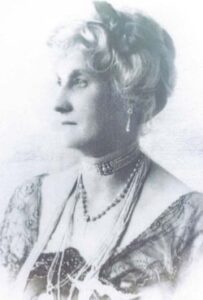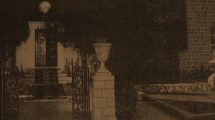 Mary Virginia Thornburgh Cropper
Mary Virginia Thornburgh Cropper
Born: 1857
Death: March 15, 1938
Place of Birth: London, England
Location of Death: Kensington, Greater London, England
Burial Location: No cemetery details
Mrs. Thornburgh-Cropper was the first Baha’i in England and one of the first Western people to recognize the Revelation of Baha’u’llah. She received the name “Maryam Khanum” from ‘Abdu’l-Baha. She put her car at the Master’s disposal during His visits to London. Her tall, graceful figure with her serene angel face shining beneath a crown of silver hair, her blue eyes, and the soft blend of blues and purples in her dress, gracious to all, and ready to be of constant service to her exalted Guest.
In a letter to Lady Blomfield, now published in The Chosen Highway, Mrs. Thornburgh-Cropper tells how she became aware of the new Revelation. “Early in 1900 I received a letter from Mrs. Phoebe Hearst, my life long friend from California, telling me of a wonderful new religious teaching she had contacted. She said that she felt it would be of great interest to me, and that when she came to London, she would tell me all about it. A short time later I was searching in the encyclopedia for some information about King David, about whom I had had an argument. In turning over the pages, my eye was caught by a name “Báb.” . . . There was something so moving in this story of a martyr for His faith, that so moved me that I went to the British Museum to search for further information regarding Him and His teaching.”
Mrs. Thornburgh-Cropper accompanied Mrs. Hearst to ‘Akka in 1902, and later made another pilgrimage in 1906, both times being received by the Master. Of her first encounter with Him she says: “Someone went before us with a small piece of candle which cast strange shadows on the walls of this silent place. Suddenly the light caught a form that at first seemed a vision of mist and light. It was the Master the candle light had revealed to us. His white robe, and silver flowing hair, and shining blue eyes, gave the impression of a spirit, rather than of a human being. We tried to tell Him how deeply grateful we were at His receiving us. “No,” he answered, “you are kind to come.” This was spoken in a very careful English. Then He smiled, and we recognized the Light which He possessed in the radiance which moved over His fine and noble face. It was an amazing experience. We four visitors from the Western world felt that our voyage, with all its accompanying inconveniences was a small price to pay for such treasure as we received from the spirit and words of the Master Whom we had crossed mountains and seas and nations to meet. This began our work ‘to spread the teaching,’ to ‘mention the Name of Baha’u’llah, and acquaint the world with the Message’.”
To many Baha’is of the present generation Mrs. Thornburgh-Cropper was unknown personally. The infirmity of her declining years prevented her from active association with the friends, but she was known as a staunch and loyal servant, and it was a delight to hear from Lady Blomfield the story of how she sent an envoy to the great Tolstoy.
She passed away on March 15th, 1938.
The following account is written by a friend who wishes to remain anonymous.
Nearly forty years ago (1902) the late Mrs. Thornburgh-Cropper in company with a group of friends made the pilgrimage to Haifa. It was during a casual conversation with an acquaintance at a hotel that she first heard of ‘Abdu’l-Baha. Some weeks later after making independent inquiries and carefully considering the real purport of the account of this remarkable Personage, she decided to take the journey with the intimate friends who had been fired by her enthusiasm.
They first went to Alexandria where they managed to secure accommodation on a steamer which would call at ‘Akka, the ancient seaport of Syria. This was a notoriously rough sea passage at the best of times but on the day of their disembarkation it was necessary for the ship to lower boats as she could not make the port.
One can imagine the daring adventure for these ladies accoutred in the voluminous apparel of that day when they had to make the tricky descent into a rowing boat which had been brought alongside the ship on the crest of an accommodating wave! Except for a soaking wet trip to the pier the party were none the worse for their experiences.
They stayed the night at ‘Akka and the next day drove about a dozen miles to Haifa in a lumbering landau drawn by high-spirited Arabian horses.
At this period of his life ‘Abdu’l-Baha was virtually a prisoner in His large greyish stone house in Haifa. Although there was no visible guard enforcing this incarceration it was believed that He was on parole not to leave the premises without permission from Turkish officials.
Several members of His family lived with him and when the travellers arrived they were graciously received by the ladies or the household who showed them into a spacious room furnished only with a few small tables and upholstered seats against the walls. Armchairs were specially brought for the Western visitors. Then coffee and a variety of sweet meats were served.
They had not long to wait before a turbaned figure clad in flowing white robes appeared in the doorway. It was the Master.
It would be difficult to describe the effect created by the Master’s presence. As He sat there the light from an opposite narrow window focused upon His countenance revealing the finely modelled manly features and the large arresting grey blue eyes. In those eyes were mysterious depths; a glow of luminous inner power holding the secrets of a great soul.
With the assistance of one of His daughters who spoke French, ‘Abdu’l-Baha first welcomed His guests and then began a course upon the teachings of Baha’u’llah.
This interview lasted about an hour.
When the time came for leave-taking, the Master rose and made His way across the room with the light, noiseless step more like that of a supernatural being than of a man. They watched Him as He lingered awhile in the courtyard among His flowers in the brilliant sunshine – and the finally passed on to His private quarters for rest and meditation.
The friends returned the next day at ‘Abdu’l-Baha’s invitation and had the privilege of sitting at His table. A simple repast was served, consisting of beautifully cooked rice and diced meat, besides numerous little dishes of condiments and followed by sweet meats and fresh fruit.
During most of the meal the Master gave His audience further and more detailed accounts of the Baha’i Cause.
Before the visitors left, ‘Abdu’l-Baha bade them spread the Word among their people. He also made a certain prophetic pronouncement, the general trend of which has in a large measure come to pass in the world’s history. The gist of His words is as follows:
“There will be a great struggle among the nations for material gain; abysmal darkness will envelope the nations for nearly half a century before the Light comes to show them the true way to spiritual development.”
When this group of friends returned to Europe they told those interested of their visits to the Master and gave out what they had gleaned from the teachings of Baha’u’llah.
In 1906 Mrs. Thornburgh-Cropper again went to Haifa. On this occasion she was able to gain a more comprehensive understanding of the Message. There were present several interpreters with a working knowledge of English who could produce more complete translations….
Over a period of many years, Mrs. Thornburgh-Cropper gave unstinted help to the Cause and kept in close touch with ‘Abdu’l-Baha and His family, not forgetting the younger generation who were completing their education in England. The latter always found in her a sympathetic generous friend who would never spare herself to assist them in their problems.
The first direct meeting of Western believers with ‘Abdu’l-Bahá marks a monumental moment in the development of the Faith outside of the region of its birth: the Middle East. The fifteen pilgrims included early believers who are well-known to students of Bahá’í History: Lua and Edward Getsinger, Ella Goodall (Cooper), Robert Turner, May Bolles Maxwell, Mary Virginia Thornburgh-Cropper, and, the one who made it possible–Phoebe Apperson Hearst.
The pilgrimage corrected misconceptions commonly found among the early believers, and placed the Bahá’í communities in the West on firmer footing by establishing for the first time, a direct link between them and the Center of the Covenant, ‘Abdu’l-Bahá. Little wonder then that Shoghi Effendi stated that the first Western pilgrimage to the Holy Land “marked the opening of a new epoch in the development of the Faith in the West….” – Effendi, Shoghi, “God Passes By” p. 258
Source:
The Bahá’í World. “Robert Hayden: George Ronald Publisher. 1938-1940
Permission given by George Ronald, Publishers
Horgensen, Kathryn, Wilmette Institute
Images:
U.S. National Bahá’í Archives





Add Comment